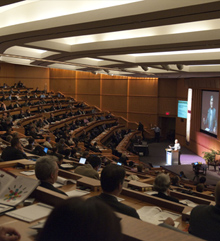|
The 2009 Medical Innovation Summit: Improving the Prognosis, Cancer Cures through Innovation was an unprecedented gathering of nearly 1000 leaders from more than a dozen countries. National coverage of the Summit included the Wall Street Journal, Forbes, Fortune, CNBC and Medical Device Daily.
Speakers at the event included CEOs and many top executives:
- Sam Palmisano, IBM
- Daniel Vasella MD, Novartis
- David Brennan, AstraZeneca
- Fred Hassan, Schering-Plough
- Richard Clark, Merck
- Greg Lucier, Life Technologies
- Margaret Hamburg, MD (FDA Commissioner)
- Maria Bartiromo (network correspondent)
At the 2009 Summit, Cleveland Clinic unveiled its list of Top 10 Medical Innovations for 2010. The purpose of the annual listing is to share the perspective of our leaders on what Innovations they felt would help to re-shape healthcare in the next year.
Months prior to the event, a rigorous selection process began, where Cleveland Clinic clinicians and researchers are asked: “What game-changing medical technology, device, or therapy do you see breaking through in 2010?” Here is the annual listing:
Cleveland Clinic Top 10 for 2010
Bone Conduction of Sound for Single-Sided Deafness
A new non-surgical, removable hearing and communication device designed to imperceptibly transmit sound via the teeth to help people with single-sided deafness. Low-Volume, Low-Pressure Tracheal Tube Cuff to Reduce Ventilator-Associated Pneumonia
A device that dramatically reduces the risk of ventilator-associated pneumonia and death in the hospital ICU by providing continuous effective airway seals. Continuous-Flow Ventricular Assist Devices
Tiny 3-ounce devices surgically attached alongside the heart that quietly and effectively take over the pumping ability of the heart. Non-Vitamin K Antagonist Oral Anticoagulants
Predictable and well-tolerated alternatives to the oral anticoagulant, warfarin, that provide a more convenient—and safe—way for patients to dose themselves and prevent blood-clot formation. Fertility Preservation Through Oocyte Cryopreservation
A rapidly-improving technology that allows eggs of a healthy woman to be safely frozen and stored, ready to be thawed and fertilized at a later date Forced Exercise to Improve Motor Function in Patient’s With Parkinson’s
Pedaling at 90 RPMs on a tandem bike to dramatically improve motor functioning of patients with
Parkinson’s disease. Outpatient Diagnosis of Sleep-Related Breathing Disorders
Self-contained, reliable, at-home sleep-monitoring devices for screening, diagnosing, and treatment assessment of sleep-related breathing disorders. Oral Thrombopoeitin (TPO) Receptor Agonist That Stimulates Platelet Production
A recently approved drug that stimulates production of cells in bone marrow that form platelet cells in the blood. Devices for Occluding Left Atrial Appendage to Reduce Stroke Risk
Device alternatives to long-term warfarin use that can prevent clots from developing in patients with
atrial fibrillation. Whole-Slide Imaging for Management of Digital Data in Pathology
A technology for creating digital pathology slides with excellent image quality that can be viewed, stored, streamed over the Internet, and analyzed on a computer.
One of the Summit highlights included keynote speaker, Dr. Margaret Hamburg, Commissioner for the U.S. FDA. The newly appointed commissioner wants to bring transparency to the agency and
“provide much more insights into our standards, expectations and our decision-making,” Hamburg said.Hamburg thinks the FDA can free up resources for companies to invest in
innovation, which was the theme of the Clinic summit. “I think the more we can expand our reach and work with companies that are producing medical products … the more we can support those
industries, make those industries more efficient, in terms of complying with our standards of practice and performance, and hopefully [enable] those same companies to be able to target resources for innovation.”
Return to Current Issue
|



 Senior executives, investors, entrepreneurs
Senior executives, investors, entrepreneurs
 Margaret Hamburg
Margaret Hamburg